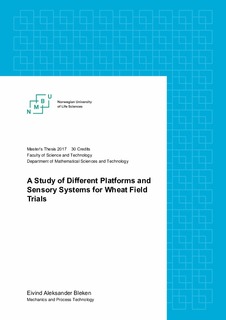| dc.contributor.advisor | Burud, Ingunn | |
| dc.contributor.author | Bleken, Eivind Aleksander | |
| dc.date.accessioned | 2017-11-08T08:37:58Z | |
| dc.date.available | 2017-11-08T08:37:58Z | |
| dc.date.issued | 2017 | |
| dc.identifier.uri | http://hdl.handle.net/11250/2464803 | |
| dc.description.abstract | In the field of agriculture several technical advances have been implemented to meet the growing demand with regards to food supply. As an indicator for grain yield in wheat different indices have been tested and evaluated such as the Normalized Difference Vegetation Index (NDVI), MERIS Terrestrial Chlorophyll Index (MTCI) and the Leaf Area Index (LAI). The first two is constructed to estimate differences in chlorophyll content while the last one is used to indicate plant coverage. They all utilize the difference in reflectance in the near infrared spectral band between healthy plants and either stressed plants or non-plants. This thesis had 96 wheat plots consisting of 24 cultivars given two different levels of Nitrogen as fertilizer, 7.5 and 15 kg/daa. A multi-spectral camera, an agricultural robot and a drone was applied to collect data throughout the season of growth. At the end of said season traits such as grain yield and plant height was measured. The plant height was digitally estimated by using digital surface models and a regression model. The indices NDVI, MTCI and LAI were calculated based on scripts using Python. The values for the last index was determined by using NDVI threshold values and the ratio between predominantly green pixels to total pixels. The correlations between NDVI and grain yield were not strong with the correlation between grain yield and MTCI in the same realm of strength. LAI showed no statistical significance on any set of data and carried no merit with regards to correlations. It did however highlight the impact the inclusion of the near infrared spectral band offers when estimating plant coverage. The correlation between manual and digital plant height values was strong and can quite possibly be stronger by enhancing the principals embedded in the method applied. | nb_NO |
| dc.description.sponsorship | Yara Norge | nb_NO |
| dc.language.iso | eng | nb_NO |
| dc.publisher | Norwegian University of Life Sciences, Ås | nb_NO |
| dc.rights | Attribution-NonCommercial-NoDerivatives 4.0 Internasjonal | * |
| dc.rights.uri | http://creativecommons.org/licenses/by-nc-nd/4.0/deed.no | * |
| dc.subject | Sensors | nb_NO |
| dc.subject | Wheat | nb_NO |
| dc.subject | Index | nb_NO |
| dc.title | A Study of Different Platforms and Sensory Systems for Wheat Field Trials | nb_NO |
| dc.type | Master thesis | nb_NO |
| dc.description.version | submittedVersion | nb_NO |
| dc.subject.nsi | VDP::Teknologi: 500 | nb_NO |
| dc.source.pagenumber | 118 | nb_NO |
| dc.description.localcode | M-MPP | nb_NO |

